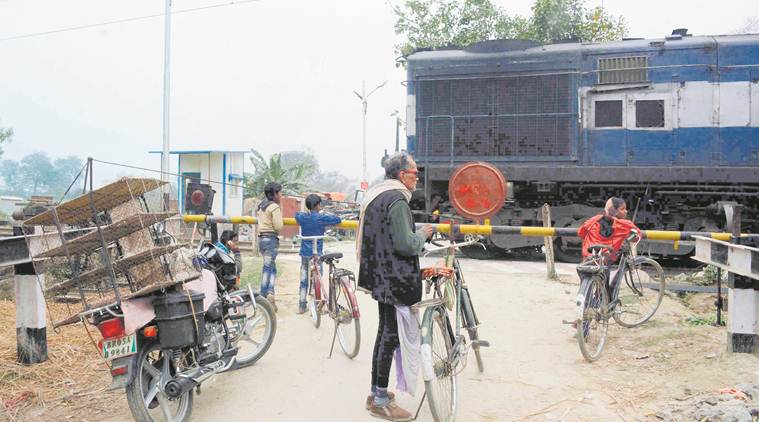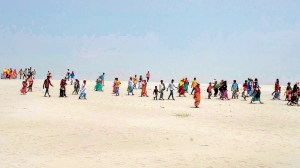- India
- International
All line clear: ‘If train delayed, commuters force me to open gates’
A tempo with 21 passengers had rammed into the Muzaffarpur-Dehradun Express at the crossing, where the gateman on duty had not shut the gates.
 Interlocking facility was installed two days after the accident. (Express photo by Nagendra Kumar Singh)
Interlocking facility was installed two days after the accident. (Express photo by Nagendra Kumar Singh)
“Doesn’t it look like a paan shop?”, asks Rakesh Kumar, a resident of Chiknauta village in Bihar’s East Champaran district, as he rides past the newly constructed gateroom at manned level crossing No. 169C near Semra Railway Station. Next to the gateroom, workers are busy mixing stone chips, sand and cement to build the foundation for an iron fencing that will extend 15 metres along the tracks on either side of the level crossing.
Read | All lines clear: Ground reality of unmanned railway crossings
The hectic construction activity began five months ago, but the trigger was an accident in August 2014, the worst train accident at a level crossing in the last five years, which claimed 19 lives. A tempo with 21 passengers had rammed into the Muzaffarpur-Dehradun Express at the crossing, where the gateman on duty had not shut the gates.
The accident occurred around 4 pm, a moderately busy traffic time, with people from villages of Sugauli Block going to the local Chhapwa market in West Champaran. Tempos or ‘Bikrams’, as they are called in these parts, are the most common mode of transport here. Overcrowded tempos that charge between Rs 10-20 per person are a common sight.
On a Thursday afternoon, commuters from the adjoining villages of Rampur, Sapaha and Khadbahas, most of them sugarcane farmers and daily wagers, stop at the crossing. Some recall the 2014 accident, and blame the tempo driver for rushing past the crossing. Others remember how the tempo was dragged for 50-60 metres by the train, killing most passengers on the spot.

Also read | ‘If train delayed, commuters force me to open gates’
Though interlocking facility were installed at the level crossing two days after the accident, work on the iron fencing began only a fortnight ago. “The four-foot-high fencing will ensure there are no collisions in the future. Work will be completed soon,” says Ravishanker Paswan, the gateman deployed two-and-a-half years ago.
Paswan, a ‘traffic porter’, and his colleague Ranjeet Sharma, a pointsman with the Railways, work 12-hour shifts to guard the level crossing. Walking around the new gateroom that was constructed after the old one, built during “English times”, caved in a month ago, he says, “We had been working from under a tarpaulin structure earlier.”
The new gateroom is yet to get a door. Inside are a plastic chair and an iron bucket; there is no toilet for the guards. “The Railway contractor promised an electricity point for a bulb. We haven’t got it. This room will be unbearable in summer, but hopefully, it will be better than the tarpaulin,” says Paswan, who stays at Motihari, 15 km from Semra, and arrives at work at 6 pm on his motorcycle.
About two dozen local and passenger trains and 15 goods trains pass through daily.
Paswan says that during festivals and the wedding season, it gets difficult to handle the rush. “It is intimidating at times. Private vehicle owners are often very aggressive. They force me to open the gates even if the train gets delayed by 10-15 minutes,” he says.
Apr 27: Latest News
- 01
- 02
- 03
- 04
- 05








































